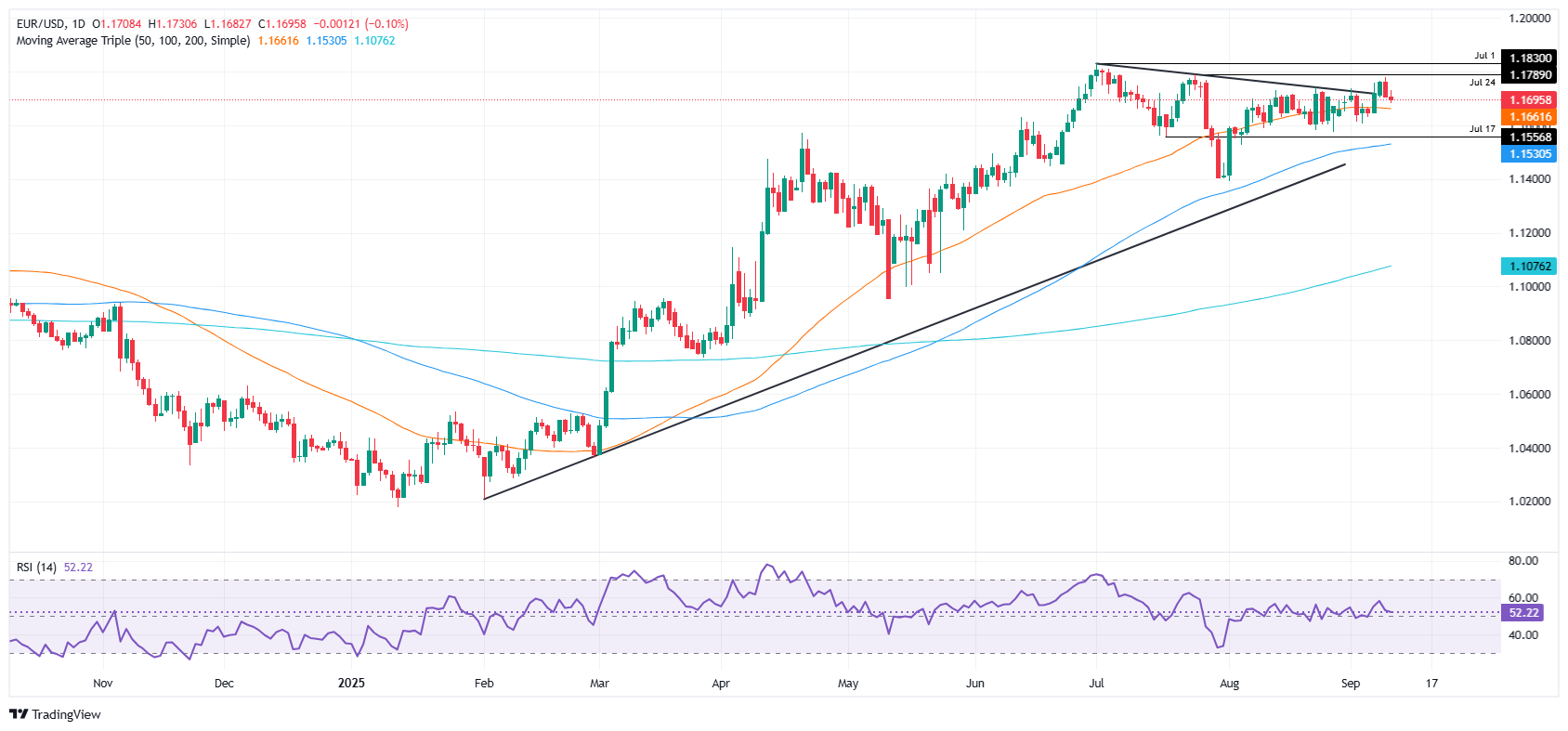EUR/USD steady at 1.1700 as softer US PPI fuels rate cut bets
- EUR/USD trades flat around 1.1700 as softer US producer prices boost Fed rate cut expectations ahead of key CPI data.
- Risk-off reaction after Russian drones violated Poland’s airspace, adding geopolitical tension to already fragile sentiment.
- Trump presses EU to impose 100% tariffs on China and India in bid to pressure Russia over Ukraine war.
The EUR/USD remains steady at around 1.1700 on Wednesday as market participants digest US economic data. US Dollar weakness triggered by a softer inflation report and growing speculation for the first rate cut by the Federal Reserve (Fed) keeps the pair trading within familiar levels.
Euro steadies as softer US PPI pressures US Dollar
The US Producer Price Index (PPI) in August was softer than projected in both headline and core prints. Despite this, the market reaction was not as dovish as expected as traders await the release of the Consumer Price Index (CPI) on Thursday and Initial Jobless Claims for the week ending September 6.
Across the pond, the economic docket was empty, yet EUR/USD traders are focused on the outcome of the European Central Bank (ECB) monetary policy meeting.
Regarding geopolitics, news that Russian drones violated Poland’s airspace triggered a risk-off reaction in the pair, which ultimately turned negative.
In the meantime, US President Donald Trump asked the European Union (EU) to hit China and India with 100% tariffs in order to pressure Russian President Vladimir Putin to end the war with Ukraine.
Daily market movers: EUR/USD traders wait for US CPI figures
- US PPI growth slowed in August, easing to 2.6% YoY from 3.3%. Core PPI also moderated, coming in at 2.8% YoY versus a downwardly revised 3.5% in July. Following the release, Fed rate cut expectations shifted slightly more dovish by 1 basis point.
- The US Dollar Index (DXY), which measures the Greenback against a basket of six peers, is up 0.10% at 97.85.
- US CPI for August is projected to rise to 2.9% YoY from 2.7%, whereas Core CPI, which excludes food and energy, is expected to hold steady at 3.1%.
- Fitch Ratings Agency expects two 25-basis-point rate cuts in September and December, with three more reductions penciled in for 2026. Conversely, the ratings agency does not project any further rate cuts by the ECB.
- After the data, traders had priced in a 90% chance of the Fed easing policy by 25 bps and a 10% chance for a 50 bps cut, according to the Prime Market Terminal interest rate probability tool. The ECB is likely to keep rates unchanged, with a 93% probability of that and only a 7% chance of a 25 bps cut.
Technical outlook: EUR/USD remains bullish despite retreating to 1.1700
The EUR/USD has posted back-to-back bearish days, which has pushed the pair below the 1.1700 figure. However, strong support lies at around the confluence of the 20-day and 50-day Simple Moving Averages (SMAs) of 1.1672, and 1.1659, respectively.
The Relative Strength Index (RSI), despite being bullish, shows that buyers are losing momentum as the print fell from 60 to 52, with sellers eyeing the 50 neutral line.
If EUR/USD climbs above 1.1700, expect a move toward 1.1750, ahead of July 24 at 1.1788. A move above the latter will expose 1.1800 and 1.1829.

Euro FAQs
The Euro is the currency for the 19 European Union countries that belong to the Eurozone. It is the second most heavily traded currency in the world behind the US Dollar. In 2022, it accounted for 31% of all foreign exchange transactions, with an average daily turnover of over $2.2 trillion a day. EUR/USD is the most heavily traded currency pair in the world, accounting for an estimated 30% off all transactions, followed by EUR/JPY (4%), EUR/GBP (3%) and EUR/AUD (2%).
The European Central Bank (ECB) in Frankfurt, Germany, is the reserve bank for the Eurozone. The ECB sets interest rates and manages monetary policy. The ECB’s primary mandate is to maintain price stability, which means either controlling inflation or stimulating growth. Its primary tool is the raising or lowering of interest rates. Relatively high interest rates – or the expectation of higher rates – will usually benefit the Euro and vice versa. The ECB Governing Council makes monetary policy decisions at meetings held eight times a year. Decisions are made by heads of the Eurozone national banks and six permanent members, including the President of the ECB, Christine Lagarde.
Eurozone inflation data, measured by the Harmonized Index of Consumer Prices (HICP), is an important econometric for the Euro. If inflation rises more than expected, especially if above the ECB’s 2% target, it obliges the ECB to raise interest rates to bring it back under control. Relatively high interest rates compared to its counterparts will usually benefit the Euro, as it makes the region more attractive as a place for global investors to park their money.
Data releases gauge the health of the economy and can impact on the Euro. Indicators such as GDP, Manufacturing and Services PMIs, employment, and consumer sentiment surveys can all influence the direction of the single currency. A strong economy is good for the Euro. Not only does it attract more foreign investment but it may encourage the ECB to put up interest rates, which will directly strengthen the Euro. Otherwise, if economic data is weak, the Euro is likely to fall. Economic data for the four largest economies in the euro area (Germany, France, Italy and Spain) are especially significant, as they account for 75% of the Eurozone’s economy.
Another significant data release for the Euro is the Trade Balance. This indicator measures the difference between what a country earns from its exports and what it spends on imports over a given period. If a country produces highly sought after exports then its currency will gain in value purely from the extra demand created from foreign buyers seeking to purchase these goods. Therefore, a positive net Trade Balance strengthens a currency and vice versa for a negative balance.

